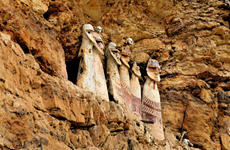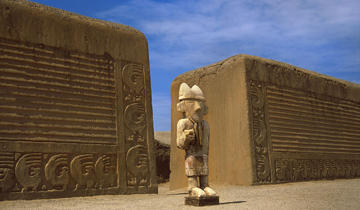

Subsequently, the culture of the Tihuanaco arose in the Sierra. Named after their religious centre in the southernmost part of Lake Titicaca (present-day Bolivia) the Tihuanaco ruled over an enormous territory during their peak (200-600 A.D.), reaching from present-day Peru and Bolivia to Chile and Argentina. The designs of the sculptures in the Tihuanaco archeological complex lead scientists to believe there is a connection between the Chavín and Tihuanaco cultures. From La Paz, Tihuanaco can be visited in a day.
Finally, the Chimú was the last important culture preceding the Inca. Their empire (1250-1470) extended on the coastline between present-day Ecuador and Lima. The founding walls of their cultural centre Chan Chan, then the biggest city of South America can now be admired near Trujillo. It is estimated that 60.000 people lived in this adobe city.
Heavily influenced by the Paracas Culture, a new culture was born in the South of the Ica region: the Nasca-culture (200-600 AD). This culture gained most of its recognition throughout the world thanks to German-born archaeologist and mathematician Maria Reiche, who dedicated her life to the study of the so called Nasca lines; mysterious, geometric figures carved in the desert sand. The Nasca performed primitive skull surgery that relieved pressure on the brain from battle wounds or for ritual purposes. The operations were successful, as one can find out in several Lima museums.
The Nasca lines are a series of drawings of animals, geometric figures and birds ranging up to 300 metres high and several kilometres long. They can best be admired from the air. The Regional Nasca Airport offers several flights.
The Chachapoyas (800-1600 A.D.), also called the Warriors of the Clouds, thrived in the North East Andes near the present-day cities of Tingo, Leymebamba and Moyobamba. In spite of their constant resistance, they were conquered by the Inca in the late 1400´s. Their most famous legacy is the Kuélap fortress in the Utcubamba Valley in Northern Peru.